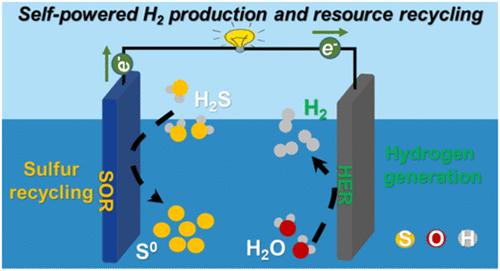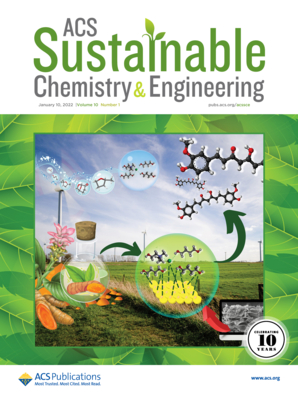Self-Powered Water Electrolysis with Sulfide Waste as Consumable
IF 7.1
1区 化学
Q1 CHEMISTRY, MULTIDISCIPLINARY
引用次数: 0
Abstract
Water electrolysis is a powerful and environmentally friendly strategy for green H2 production. However, the kinetics and efficiency of this process suffer seriously from the sluggish oxygen evolution reaction. Here, we report a fully self-powered H2 production approach coupling a hydrogen evolution reaction with a sulfide oxidation reaction. Driven by a sulfidic spent caustic stream, the lab-scale flow reactor can deliver an open-circuit voltage of up to 0.44 V and a self-powered current density of up to 33.79 mA cm–2. A hybrid NiCu-doped MoS2 catalyst is prepared using a nickel–copper etching waste fluid, which can effectively catalyze sulfide oxidation and hydrogen evolution. The conversion efficiencies for waste chemical energy to electricity and H2 are >40% and >30%, respectively. This work strongly suggests a self-powered H2 production potential and ability by coupling water splitting with small-molecule waste treatments, with substantial benefits concerning energy conservation, waste treatment, and resource optimization.

以硫化物废料为消耗品的自供电水电解技术
本文章由计算机程序翻译,如有差异,请以英文原文为准。
求助全文
约1分钟内获得全文
求助全文
来源期刊

ACS Sustainable Chemistry & Engineering
CHEMISTRY, MULTIDISCIPLINARY-ENGINEERING, CHEMICAL
CiteScore
13.80
自引率
4.80%
发文量
1470
审稿时长
1.7 months
期刊介绍:
ACS Sustainable Chemistry & Engineering is a prestigious weekly peer-reviewed scientific journal published by the American Chemical Society. Dedicated to advancing the principles of green chemistry and green engineering, it covers a wide array of research topics including green chemistry, green engineering, biomass, alternative energy, and life cycle assessment.
The journal welcomes submissions in various formats, including Letters, Articles, Features, and Perspectives (Reviews), that address the challenges of sustainability in the chemical enterprise and contribute to the advancement of sustainable practices. Join us in shaping the future of sustainable chemistry and engineering.
 求助内容:
求助内容: 应助结果提醒方式:
应助结果提醒方式:


